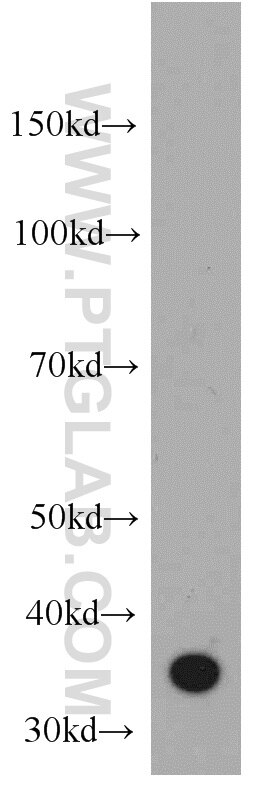Anticorps Polyclonal de lapin anti-CD336
CD336 Polyclonal Antibody for WB, ELISA
Hôte / Isotype
Lapin / IgG
Réactivité testée
Humain
Applications
WB, ELISA
Conjugaison
Non conjugué
N° de cat : 55118-1-AP
Synonymes
Galerie de données de validation
Applications testées
| Résultats positifs en WB | tissu splénique humain |
Dilution recommandée
| Application | Dilution |
|---|---|
| Western Blot (WB) | WB : 1:500-1:1000 |
| It is recommended that this reagent should be titrated in each testing system to obtain optimal results. | |
| Sample-dependent, check data in validation data gallery | |
Informations sur le produit
55118-1-AP cible CD336 dans les applications de WB, ELISA et montre une réactivité avec des échantillons Humain
| Réactivité | Humain |
| Hôte / Isotype | Lapin / IgG |
| Clonalité | Polyclonal |
| Type | Anticorps |
| Immunogène | Peptide |
| Nom complet | natural cytotoxicity triggering receptor 2 |
| Masse moléculaire calculée | 31 kDa |
| Poids moléculaire observé | 36-44 kDa |
| Numéro d’acquisition GenBank | NM_004828 |
| Symbole du gène | CD336 |
| Identification du gène (NCBI) | 9436 |
| Conjugaison | Non conjugué |
| Forme | Liquide |
| Méthode de purification | Purification par affinité contre l'antigène |
| Tampon de stockage | PBS with 0.02% sodium azide and 50% glycerol |
| Conditions de stockage | Stocker à -20 ℃. L'aliquotage n'est pas nécessaire pour le stockage à -20oC Les 20ul contiennent 0,1% de BSA. |
Informations générales
CD336, also named as NCR2, LY95 and NKp44, belongs to the natural cytotoxicity receptor (NCR) family. It is cytotoxicity-activating receptor that may contribute to the increased efficiency of activated natural killer (NK) cells to mediate tumor cell lysis. It is expressed on activated human NK cells. CD336 displays a single extracellular Ig-like V domain and a transmembrane portion containing the charged residue (Lysine), likely involved in the association with KARAP/DAP12 molecules. The antibody is specific to CD336.
Protocole
| Product Specific Protocols | |
|---|---|
| WB protocol for CD336 antibody 55118-1-AP | Download protocol |
| Standard Protocols | |
|---|---|
| Click here to view our Standard Protocols |


